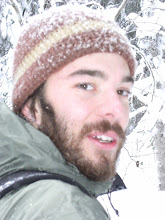
I wouldn't have known simply judging from the somewhat depressing ride in on the dirt roads, that any facsinations could exist out here. Houses and trailers were scattered along the road, many with furniture, appliances and spent cars hanging in the yards. I passed an overlook that sums up the general land ethic pretty well.
 However, the people I would soon meet reassured me that there are always exceptions to the rule.
However, the people I would soon meet reassured me that there are always exceptions to the rule.Waking early the next morning I bagged up some of my valuables and stashed them a ways into the woods as the trailhead was isolated and my truck seemed a likely target. I picked a spot on the map called the Bee Branch Scenic Area as it looked like canyon topography. I hiked for several miles down old forest service roads of caramel colored dirt, slowly being taken back from civilization. This post marks where the road used to run.
 Most of the wilderness is a mix of second and old growth hardwood forest. Large white oaks stood out in the often sparse undergrowth. Shagbark hickory are interspersed with the midstory dominated by large leaf magnolia (below), giving the forest the tropical feel that pervaded in spots.
Most of the wilderness is a mix of second and old growth hardwood forest. Large white oaks stood out in the often sparse undergrowth. Shagbark hickory are interspersed with the midstory dominated by large leaf magnolia (below), giving the forest the tropical feel that pervaded in spots.
 A crab spider.
A crab spider.As I neared Bee Branch, things started to smell a little more dank. There were rhododendren and hemlocks. As I reached the top of the box canyon I looked down into the lush opening and immediately spotted, what I would later hear referred to as the "big tree." That pretty much sums it up. It is a tulip poplar, one of many in the canyon, that escaped the saw through inaccessibility.



Normally a waterfall flows over the lip of the sandstone here. But with the several year drought in the Southeast, flows are restricted to winter and spring for the most part.
 All of the overhangs in this area were deep and dark. Unfortunately a lot of the sensitive areas in this particular canyon have been loved to death for decades now. walking around the bluffs and overhangs I came across a few fire rings. One with tinfoil, water bottles and candy wrappers strewn about. It's blatant littering, the kind of which is tougher to find in OR or Duluth area trails.
All of the overhangs in this area were deep and dark. Unfortunately a lot of the sensitive areas in this particular canyon have been loved to death for decades now. walking around the bluffs and overhangs I came across a few fire rings. One with tinfoil, water bottles and candy wrappers strewn about. It's blatant littering, the kind of which is tougher to find in OR or Duluth area trails. 
 This trail was a good introduction the knowledge I was about to gain about the area. I was able to hike the next day in a far more remote area and get a feel for the stark contrast between on and off the beaten path.
This trail was a good introduction the knowledge I was about to gain about the area. I was able to hike the next day in a far more remote area and get a feel for the stark contrast between on and off the beaten path.

No comments:
Post a Comment